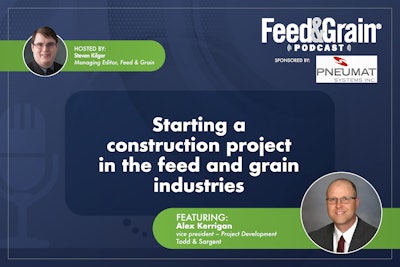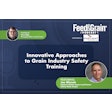
Welcome to the latest episode of the Feed & Grain Podcast, hosted by Steven Kilger. In this two-part series, Alex Kerrigan, vice president of Project Development at Todd & Sargent discusses the intricacies of initiating construction projects in the feed manufacturing and grain handling sectors. Kerrigan, drawing from his extensive background in agricultural operations and project management, shares invaluable insights on essential pre-construction considerations. From logistical planning to community engagement and navigating regulatory hurdles, Kerrigan provides practical advice to ensure the success and profitability of construction ventures in the feed, manufacturing, and grain processing sectors.
Podcast sponsored by Pneumat Systems.
Transcript has been edited for clarity.
Steven Kilger (00;00):
Hi, everyone. My name is Steven Kilger. I'm the managing editor of Feed & Grain Magazine and the host of the Feed & Grain podcast. Thank you so much for joining me today. As we dive deep into the issues affecting the feed, manufacturing, grain handling and allied industries.
Today's episode is brought to you by the BinWhip and Pneumat Systems, Inc. The powerful Duel Impact Bin Whip removes the toughest build up and blockages in industrial storage silos without hazardous silo entry. Learn more today at binwhip.com.
Today's episode is the first of a two-parter with Todd & Sargent’s Vice President of Product Development, Alex Kerrigan. We're talking about what it's like to start a construction project in the feed, manufacturing, grain handling and processing industries. We discuss what it's like to start a project like this when they get a contractor and what information they need to help you build your best project.
I hope you enjoy the interview. If you want to help out the podcast and are listening to this in a podcasting app, please write us a review and subscribe. It helps out the podcast a lot. If you're listening online, sign up for the Feed & Grain Newsletter, Industry Watch, to see the latest podcasts and stay up to date on all of the latest news from around the industry. Now onto the show.
Kilger (01;12):
Hi, Alex. Thanks for joining us today. I really appreciate your being here.
Alex Kerrigan (01;15):
Yeah. Great to be here, Steven. Thank you very much for the invite. Looking forward to chatting a little bit through the construction or pre-construction items that the customer should think about when building the facility.
Kilger (01;27):
Yeah, it's a really good topic. I've known Alex for ten years now, which is crazy to think about. But you're one of our favorite experts on any of these kinds of topics, so we appreciate you sitting down with us.
But for anyone who hasn't known you for the past ten years, can you tell me a little bit more about yourself and what you do at Touted Argent?
Kerrigan (01;56):
Yeah, I've been a Todd & Sargent. I interned here back in 1998, just in both the field a little bit and estimating and testing design over a short time period during the summer. It's funny I graduated college with more of a finance background and wanted to learn more about the inner workings of a private company, and the financial side of a private company.
And then the more I got around the design piece and the project management piece, I gravitated towards that instead. So I've got an agricultural background. I've been around these smaller facilities for years since I was, I don't know, probably sixth, seventh grade, helping my dad out on the farm and also around our grain elevator and feed mills locally from southern Iowa.
I still farm down there with our family. We've got a, again, a small grain elevator/dryer system down there. It's kind of nice to just beat around and understand concepts and equipment in general. And then, of course, I probably get into my own little, I'll say owner project management on small projects down there as well. So at any rate, yeah, I've been a town sergeant since 98 in turn and back in the swing of things and to full time and I've gone anywhere from working on grain elevators and feed mills to more involved processing on, say, soy crush facilities, expeller plants, pet food facilities quite a bit in the biodiesel industry, managing jobs on biodiesel and a little bit of ethanol where you're gosh, 15, 18 years ago, quite a bit in the flour milling industry. Really enjoy the flour and feed side both. I enjoy these complex facilities that take a lot of interaction or coordination between owners the process technologists and the construction site engineering or construction alike.
So I guess my biggest desire and growing up and what I do today is just organizing facilities to be more efficient. And, you know, my love for agriculture is just making things better, whether it's in how we go about constructing or how we go about processing the grain and logistically how to get it there and how to get the finished product out.
So it's a little bit about me.
Kilger (04;13):
Yeah. You. You. Yeah. You've been involved in some huge projects over the years. Some of the biggest stories we've ever covered at FT and Great have been Todd & Sargent stories. And it's also really nice to hear that you're still on that hobby farm. Are you still you still do that? Because I always remember talking about you around harvest season and it's you know, it's got to be pretty relaxing, right, to be able to go from the to regular just, you know, go down to the farm and get out there on the combine and harvest some great stuff like this respite.
Kerrigan (04;48):
Yeah, most people know they're sitting around on the tractor. It gives you it gives you time to introspect or sit in the combine, but also it helps me just kick back, relax a little. And if, if concepts sergeant or design concepts happen to pop into my mind as I'm tooling around out in the middle of the field, that's it's a nice time for me just to try and envision certain ideas that come from a customer or how to implement best practices from a vendor or a subcontractor that we team up with on a job.
And yeah, I enjoy, I enjoy working at Todd & Sargent in all of our teams and especially with the owners that we get to interact with. But I also like having that little bit of free time to think about or like I said, just envision what we might construct for our customer as well.
Kilger (05;36):
Yeah, definitely. I only understand that from writing where, like, the best way to get rid of writer's block is like to go for a long drive and just kind of think to yourself there in the seats. So I imagine it's similar, but we haven't been able to talk about the beginning process of a facility that might want to upgrade or might be thinking of upgrading, renovating, or building a new site and kind of what information they should start to gather before they talk to someone and when to talk to someone and what to talk to someone like you about.
So starting before engaging with the construction company, what kind of essential information should companies really gather to ensure that it's going to be a successful project and that they have everything ready for you to give your input
Kerrigan (06;26):
I guess the few different hats that I wear at Todd & Sargent, you know, we're thinking about conceptual design and how to interact with a customer, whether it's just the process design or specifications, just negotiating the final sales package and everything. But some of the things that an owner wants to be thinking about or what's, as you said, what's the essential information that companies can gather ahead of time?
A lot of owners, this goes without saying they already have this in the back of their mind, but there are some owners that don't consider these items of what's the distance or how far away are you logistically speaking? What's your access to raw materials and to the backside of it? What's your distance or access to the end user customer?
What I mean by that is if you're building a feed mill in a particular locale, is it a feed mill that's in close proximity to corn being grown, or do you need to bring in everything by rail? And then the second part of it is or that back end part of it is, is your facility close by where you're capable of just throwing something on a truck in bulk or maybe bulk bags or just smaller £50 bags and send it over to an end user?
Or do you need to be thinking about a much more involved logistical setup of loading out railcars or, you know, I mean, it still could be a pretty complex thing to be trans-loading from a well I don't know, say it's a into a van trailer versus dumping it into a hopper bottom semi. So that's a big thing is understanding the distance and understanding the costs involved like I said I think a lot of customers have that in mind from the get-go when they're when they're citing a facility.
The other thing they do and these are some things that you don't hope you can just kind of force through if you're an owner maybe, or at least you hope for the best, is do the neighbors, do they want you there? You know, there's there have been discussions, you know, complexes in Kansas that have been hey, no, we don't we don't want you there.
You know, there's that I think about export facility down Louisiana. You know, maybe the neighbors don't want you there. It sounds crazy, but, you know, being a good neighbor means a lot interacting with the local chamber of commerce or I'm sorry, economic development means a lot. And you have to just think through that. And what state your thinking about building that and what location you're thinking about building it?
Will the permitting be an uphill battle that outweighs or actually outweighs the site's benefits or will everything fall into place and make your entire process of construction and eventually operation of the facility profitable and I'll say synergistic with the locals?
Kilger (09;26):
Yeah, people really underestimate how important it is to have the community on your side. Interesting little side story that I might cut from this, but I think is really interesting is I got a call from an NPR reporter covering that facility down in Louisiana that there were all those protests for and they're trying not to get built.
As a little background person, which I was very excited about because I was like, I've never been a background consultant for anybody before. This is fun. And he's asking me all these questions and he's like, well, like, are there concerns about dust and stuff, you know, justified or smell and noise? I'm like, I mean, no, because you can build facilities.
I mean, we have equipment to get rid of dust. We have collectors, and they're a lot cleaner than they've ever been. Same with noise and same with, you know, air pollution and smell and stuff like that. And then, of course, he used none of that in the article. It just kind of was like, Yeah, it's going to smell like, that's not what I said at all.
Kerrigan (10;26):
You're right I mean most everything with a facility in a particular locale can be mitigated it's it is a matter of cost though I mean obviously the cost of a does system versus no death system is.
Yeah, there's there there's additional cash that needs to be or a cash outlay for that for that particular system. And you know it happens with noise pollution, light pollution, etc. All of those things are certainly things that can be taken care of with additional cost. But, you know, there's other things besides just keeping the locals happy too. Does it?
Does the railroad like say if you've got a railroad that you're working with, do they want to service your site? You know, the biggest thing that we find on it, at least any project that involves railroad service, is the customer starts talking to them maybe three months in advance of wanting to break ground. And that's good that they're talking to them.
But you'll find in I think everybody is that's maybe listening is aware that you know that the railroad has a they've got a lot of approvals they need to get through. They have a lot of safety checks. They want to confirm. They want to make sure the engineering of your facility or what their locomotive might be driving process is well constructed or well engineered and well thought through.
And so you want to make sure that the railroads are able to service your site and that they're they've given you kind of an idea of what the timeline will be of when you'll actually be able to get service so that's a big one. Obviously, almost everybody listening is aware that the facilities that are being constructed, be it a female or a grain elevator, an annex, storage, flour mill, whatever it may be, are tall facilities.
I mean, grain is stored upright for the need of utilizing minimal space. And with these being tall facilities, you need to be in conversation with the local airport or the FAA to make sure that there are no objections to your plant location or the height of your facility or that that, you know, the manufacturing plant or whatever you're thinking about building.
Yeah, yeah, definitely. See, these are all things that especially when you're caught up in the moment, you might kind of just forget about it until you're, you're way more into the thick of things. So at what point should a company really start a dialog with a company like yours, an engineering design construction company?
Yeah. So we always say in the feasibility study, it doesn't mean it doesn't matter if you're talking to Todd & Sargent or any other contractor out there, you know, the earlier we can get an idea of what you're thinking about building and some of the nuances of the job or the site itself, the smoother things will go.
Yeah, if I wanted to just a package answer of when you should start. I mean, hell, I've worked on facilities where it's been ten years in the making and then we finally broke ground. I've worked on facilities where the owners had a lot of these these ducks in a row, so to speak, already within within, you know, 4 to 6 months where we're breaking ground and working away, you know, that the owner needs to be talking to utilities about, you know, whether it's the railroad that I just mentioned, if it's electrical, if it's water, sewer, gas, you know, what's the water, water quality that's needed for the boiler, the the delivery volume for either domestic use or the boiler use or hell, maybe even a fire suppression system. You know, those are things that they want to be getting done as soon as they possibly can. You know, that could certainly be something that's a year in the making, a year in advance. You need to be thinking through. He is my site. Is it culturally or environmentally sensitive?
I do. I need to get an environmental firm, you know, on retainer to start thinking about the air permitting there. There are a lot of a lot of states and provinces out there that, you know, it could be anywhere from 6 to 12 to, I'll say 6 to 12 months with the air permitting. And, you know, certainly other environmentally sensitive areas, like if you have a wetland that needs to be mitigated, you know, that could it can take some time to get those permits in hand or if it's on a culturally sensitive site and you need to get a cultural resource management company involved to do a survey or talk mitigation, you know, that's something that should be thought about a year or two in advance. Something I, I guess threw this out. What I, what I find happens a lot is an owner sees this pristine parcel of land or they're given this pristine parcel of land by a, I don't know, let's say an industrial park group or whatever. And it looks great up on top.
But there's a lot of things that can happen from a civil design of, you know, how much dirt needs to be moved or worse yet, how much needs to be imported from off-site to build up this nice piece of ground. And then, hey, what's going on underground? You know, the geotechnical needs you need. It is ideal to get a soil report and you know, a few soil borings done as soon as you're able.
Just so you know, what you're getting into at this particular parcel, you know, you might think you're buying it for 3000 bucks an acre and it's, Hey, man, that seems pretty cheap versus 10,000. And then you realize, my gosh, this soil underneath is nothing but mucky silt or fat place. And it's going to force me into, you know, a million, million and a half dollars worth of piling or something.
Those are those are things that you usually say to a construction company, Hey, I just want to get a price on this facility. But you don't you don't always think through what might be underground and how you have to support these massive structures.
Kilger (17;03):
Yeah. And I'm sure, especially with people who have, like done a new project in a long time, I mean, all those regulations and all those things, if assume got more strict, it also probably take a lot longer than people think they're going to do, which is, you know, bureaucracy of governments on all levels.
Kerrigan (17;22):
Yeah. You know, that's like you said, Steve, that's that's on the, you know, more of the authorities having jurisdiction or servicing folks.
But you also have a lot of interaction not just with a top insurgent type group or construction group. You got a lot of interaction with your your industry partners like a technology provider. You know, if it's a it's it's a brand new greenfield site flour mill, you know, there's probably a a lot to be discussed with a process technologist of what your outputs are and how you're going to fit it around.
And that's going to that's going to determine what the footprint is of your actual structure to to house all this equipment. You know, if you get a female that's a little, you know, 30 by 40 footprint for an ingredient to bin tower and a little 30 by 40 footprint or a 20 by 40 footprint maybe for the out lanes.
That's one thing. If you're looking at a big old female with three clothing lines and more like a 50 by 60 ingredient tower and, you know, two or three load-out lanes and save a couple of million bushels of grain storage. I mean, that that's a lot. And that's just you know, that's just the footprints. You still have to determine what's needed for the traffic flow around that facility what you need for roadways and how you interact with the civil engineer to determine not just how much dirt needs to be moved there, but how you actually move water across the site, what drainage is necessary to to to have a long-lasting site that you know, you're happy with for for 100 years to come.
Kilger (19;09):
Hello again. It's me, Steven. Just hopping back in at this point to let you know the second part of this interview will be coming next week. But until then, thank you for listening, and stay safe out there.
.jpg?auto=format%2Ccompress&crop=faces&fit=crop&h=48&q=70&w=48)


















